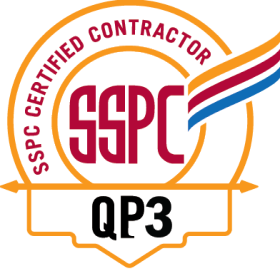As steel fabricators of industrial storage tanks, we at T BAILEY LLC hear a lot of field-erected tanks frequently asked questions. So to help our potential customers and readers on Google find the answers they’re looking for, we’ve compiled this list of FAQs, with answers given by some of the leading experts in our fab shop.
1. How Large Can a Field-Erected Tank Be?
The codes and standards that regulate field-erected tank construction have nothing to say about maximum tank size. So, in theory, as long as the requirements set by API 650 or AWWA D100 are being followed, the sky is the limit!
In practice, however, there is a capacity limit at which it becomes more affordable to build multiple tanks instead of one large one. This is why tank farms are typically chosen over the construction of a single, massive reservoir.
But, for the sake of argument, how large can a single tank be? Here at T BAILEY LLC, our tank fabrication experts have built massive reservoirs over 184’ in diameter and with capacities hitting 10 million gallons.
2. How to Determine If I Need a Shop-Built or Field-Erected Tank?
Shop-built and field-erected tanks each serve the same purpose — to store products. The difference is that one is fabricated and assembled in the shop and then shipped to the job site as a turn-key product, while the other is constructed at the job site.
Each kind of tank can get the job done, so economic factors are usually what determine which style of tank you select.
For example, while pressure vessels can be built on-site, it’s usually cheaper to get them built in the shop.
Another factor that influences this decision is site access. For instance, if your job site can only be accessed by truck and you need a 30’ diameter tank, then you’ll need a field-erected tank, as the largest tanks that can be trucked are 12’ in diameter.
3. What Kind of Site Work is Required Before Building a Field-Erected Tank?
The site preparation for field-erected tank construction is similar to building any other structure, like a house or office building. Site work we do includes:
- Clearing trees & removing stumps
- Demolishing old buildings or existing tanks that occupy the site
- Site surveying
- Soil testing
- Site grading
- Excavating & pouring foundation
- Piping & utility installation
- Installing security
- Building pump house
- And more…
As a general contractor, T BAILEY LLC handles every step of the field-erected tank construction process, including all the site preparation.
4. What Are the Site Limitations? When Can You Not Build a Tank?
Access is the primary factor that determines whether or not you can build a field-erected tank.
For example, we only construct field tanks if the job site is accessible to a tractor-trailer rig. This limitation is put in place because we need to ship all the steel parts and equipment to the job site via tractor-trailer.
Another limitation is that all sides of the tank must be accessible by crane. This can prevent us from building medium-sized tanks in tight sites, as there may not be room to position our crane on the outside of the tank. The alternative is to cut a door sheet and put the crane inside, but medium tanks are typically too small for this. We can, however, reach the far side of smaller tanks with crane access from only one side.
5. What’s the Lifespan of a Field-Erected Tank?
There are tanks that are celebrated by the Steel Tank Institute for lasting over 100 years.
Water tanks are especially adept at lasting for 50-100 years, as they have interior and exterior coatings that preserve them better than uncoated tanks. So your AWWA D100 water tank should last as long as you maintain coatings.
As for oil tanks, it’s not uncommon to have API 650 tanks that last 50+ years (so long as proper inspection cycles are maintained).
Two techniques to help you extend the longevity of your tank include:
- Cathodic Protection; placing cathodes and anodes inside the tank helps slow down corrosion and can stop the bottom plates of a tank from corroding from the outside in.
- El Segundo Bottoms; a specialized procedure that replaces the bottom section of a corroded oil tank. Mitigates the cost of building a new tank.
6. What Kind of Material Can a Field-Erected Tank be Constructed From?
Field-erected tanks are usually built from either steel or concrete. Here at T BAILEY LLC, we only fabricate steel tanks (carbon steel or stainless steel).
While concrete tanks may seem like a cheaper alternative to steel tanks, the reality is that leaks, cracks, and bacterial growth make concrete a risky option.
Steel tanks are more durable, able to withstand decades of service in harsh conditions without compromising the quality of the stored product. And this is why concrete tanks have a maximum lifespan of 60 years, while steel tanks are still standing 100 years later.
A Trusted Tank Fabricator Near You
T BAILEY LLC has been building steel tanks since 1991, giving us the experience and proven track record necessary to confidently take on any kind of field-erected tank project. If you have more questions about field-erected tanks, browse our blog, or contact our fab shop today to get your tank project started.






